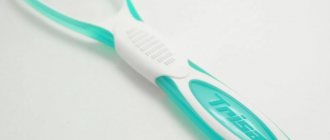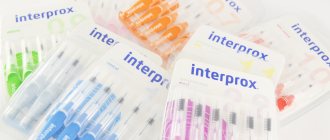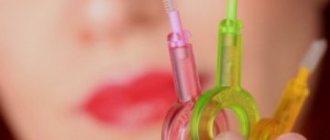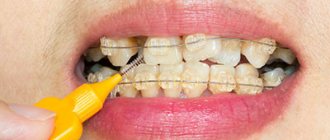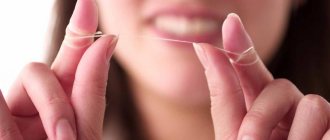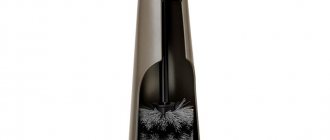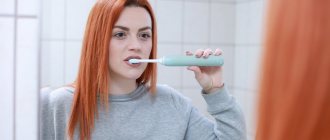Beautiful and straight teeth, which are the most important component of a person’s attractive smile, indicate not only his self-confidence, but also the health of his teeth. Not everyone is lucky enough to have such teeth from birth, but existing defects can be corrected in almost any case with the help of braces. True, you cannot limit yourself to just installing the system; it requires appropriate care, in particular, you will need to perform certain actions, including a toothbrush for braces. It differs from its counterpart in normal mode, since it is designed to solve quite specific problems; the features of its use and other subtleties will be discussed below.
Adaptation period
Getting used to the system and the devices used to care for it will take some time. While adaptation continues, the patient will have to experience some discomfort when eating, and he will also have certain problems with diction, but there is no need to be afraid and despair, such troubles will be overcome quite quickly.
On average, an adult will need no more than 10 days to get used to it; a teenager or young man will need even less, a maximum of a week. Painful sensations may not necessarily occur only in the teeth that experience pressure from the plates; often the gums also experience discomfort. If adaptation is very difficult, then the dentist may, at the patient’s request, slightly weaken the system so that the painful sensations are not too strong; in addition, it may be necessary to take painkillers.
A special place is occupied by special means that are used to care for oral hygiene. Their use extends throughout the entire period of wearing braces; moreover, care during this period should be especially thorough.
Description of the capabilities of brushes
The bracket system has a lot of small elements. During a meal, food particles often get stuck between structural parts. Traditional accessories for cleaning teeth will not be enough if a person wears braces. Contamination should be removed immediately. Special orthodontic brushes (brushes) do an excellent job of this. The modern market for hygiene products offers a huge variety of such tools. They make cleaning teeth and braces of all types much easier.
Brushes for braces can be purchased at a pharmacy, supermarket or dental store. The price varies between 300-500 rubles, and depends on the manufacturer’s brand. Products from brands such as Rox, Colgate, and Oral B are popular. An orthodontist will help you avoid mistakes when choosing an accessory. He, taking into account the personal characteristics of the patient and the installed braces, will recommend the most suitable type of brush for cleaning the device.
Brushes designed for caring for braces come with different tips:
- with forked;
- with extended ones;
- with shortened ones.
To achieve impeccable oral cleanliness, you need to know how such products should be used. The skill of correct use is developed after just a few procedures.
Brushes for braces
It is worth noting that if you neglect the use of special brushes for cleaning braces, then soon after installing the corrective system you may encounter many troubles, namely: the formation of plaque, caries on the teeth, as well as inflammation of the gums, changes in the original shade of the braces (especially vulnerable in in this regard, plastic and ceramic products). Pigmentation causes the device to become visually unattractive.
What is important for a braces wearer to know?
Although the cleaning procedure is not particularly difficult, it still requires some effort and time, therefore, to make the process more effective, we can recommend the following to the patient:
- purchase a magnifying glass that will help you better see food particles on your teeth;
- When cleaning, you should rinse your mouth in order to monitor the quality of the actions performed in real time;
- if you couldn’t find a special brush, you can make it from a regular one, which you just need to cut out the fibers on it from the central part.
Regarding the cleaning process, we can also recommend the following procedure to the patient:
- In the gum area, place the brush at an angle and make several rotational movements to clean.
- Each tooth should be cleaned, both from the inside and from the outside.
- You should not be afraid to touch the structure of the system itself; you should carefully brush it on both sides.
- The space between the teeth must be treated using special brushes.
- The procedure should take at least three minutes and should be completed by rinsing.
If you have braces
If an orthodontic system is installed, the brush is the only device that helps to properly clean it. Its use allows you to prevent the accumulation of plaque and pieces of food under the locks, and therefore prevent caries and the appearance of stones. The recommended frequency of cleaning them is at least 2 times a day.
For braces, a conical model should be used. Its narrow upper part cleans all small parts well, and its wide lower part removes food debris from the interdental spaces.
Braces are cleaned in the following sequence:
- Perform routine teeth cleaning.
- Work the locks using back and forth movements.
- To clean the arch: insert the product between the teeth and the arch, and slowly turn it in a circle.
- Cleaning the arc attached to the outside is also done.
- Rinse the device, dry it and close the cap.
Important: after completing the processing of each individual element of the system, the brush is washed with running water.
Choosing the right brush
The choice of options in stores is very large; you can find various sets that differ in the length and stiffness of the bristles. The choice of a specific option depends on the doctor’s recommendations and your own preferences. There are these types of toothbrushes for braces:
- orthodontic, having a small head and forked bristles;
- electrical, characterized by excellent functionality and quality of work;
- Mono-beam, capable of reaching, due to its length, the most remote and hard-to-reach areas in the mouth.
What exactly to choose is not so important; the main thing is to know how to use the brush and get used to it.
Proper Teeth Brushing Technique
So, it is important not only to take care of your mouth with braces installed, but to do it correctly. If you overdo it with care, you can provoke the structural elements to peel off from the teeth, but if cleaning is not done well enough, then there is a risk of caries.
The rules of care, meanwhile, are quite simple and absolutely everyone can follow them:
- you need to start cleaning from the front, making first horizontal and then vertical movements;
- the design of the system and the areas around it are well cleaned by single-tuft brushes, they are especially good for back teeth;
- hard-to-reach areas can be cleaned well with brushes, which also do an excellent job with large areas;
- superfloss is essential for cleaning the interdental space;
- A regular toothbrush can clean the inside of your chewing teeth perfectly.
Yes, this procedure takes longer than traditional cleansing, but it’s not difficult to get used to, and then it will simply become a habit. It is better to spend 10 minutes every day on cleaning than to prolong the treatment procedure for months.
Product varieties
Brushes of different models allow the patient to provide high-quality oral care while wearing braces. Typically, the working area of such products is equipped with cone-shaped or cylindrical bristles. It is durable and movable, and has varying degrees of rigidity. It is made from synthetic bristles, which are hygienic and safe for health. The device holder has a small or large base - it depends on what types of teeth the item is intended for.
Mono-beam toothbrush Miradent, with 4 replaceable heads
Cleaners are disposable accessories. An orthodontic brush is used for repeated use. Its main characteristics:
- has larger dimensions;
- used to cleanse only the lingual side of the enamel;
- is used for no longer than 1 – 2 weeks (service life depends on frequency of use and wear).
In addition to the mentioned products, it is necessary to acquire dental floss, as well as other special devices that help clean the interdental spaces - brushes cannot fully cope with this task.
Nutritional Features
Installing braces implies not only compliance with the rules of caring for them, but also certain restrictions in the process of eating. So, in order not to create unnecessary problems for yourself, it is recommended to refuse:
- solid foods that can negatively affect your bite;
- sticky and viscous foods that can negatively affect the enamel;
- products with dyes, as they will change the color of the structure and make it unsightly;
- excessively cold or hot food, which can affect the physical properties of the system and reduce its efficiency.
It is important to know: A mandatory requirement is to refuse, unconditionally and completely, from chewing gum. This harsh approach is justified by the fact that the sugar it contains causes caries, plus, chewing gum can lead to braces coming off, which will lead to an increase in the number of visits to the doctor and delay of treatment.
Instructions for use
How to clean braces using brushes? There are several basic recommendations that can help you master all the required skills in a short period of time. You can perform this procedure using the following instructions:
- Brushes for braces are not the main oral care products. Before using it, you should carefully but efficiently perform a simple set of cleaning measures, during which a brush and paste are used. When all food debris has been removed, local cleaning can be performed. Each area of the teeth must be brought to complete cleanliness. First, you should select the required size brush. If the length of the pile is small enough, it will be impossible to remove all dental deposits. If the brush has too long a pile, it can injure your gums, and this will also lead to the lock coming off.
- It doesn’t matter what brand of brush you use, the instructions for using them are the same. To remove plaque, you need to hold the device perpendicularly. The bristles of the brush should easily penetrate into all spaces. When this condition cannot be met, then it is worth using dental devices with a minimum thickness.
- Cleaning the arc is easier. For these purposes, it is worth placing a brush between it and the tooth enamel. You can remove food deposits using clockwise movements.
If you use a brush after every meal, you can significantly reduce the risk of caries and gum disease. In addition, your orthodontic system will delight you with its primary beauty throughout the entire time you wear it.
After removing braces, you can use a brush to achieve a deep cleaning of the oral cavity. The presented products allow you to protect you from plaque and get a Hollywood smile. It is very important to use this product regularly so that plaque does not turn into tartar, which requires the help of a specialist to clean.
Lifetime
Answering the question about the duration of wearing the structure is not as simple as it might seem. This aspect is influenced by the following factors:
- the age of the patient - the younger he is, the less time is needed;
- degree of complexity of the problem - the simplest situations will require wearing the system for no more than a year, the most complex ones will require much more time;
- the health status of the patient's teeth - if there has been no prosthetics or depulpation before, then the wearing time will be shorter.
Three years, if we talk about the most problematic cases, of course, is a considerable period of time; to many, even one year seems an unreasonably long time, but it is still not worth using devices for acceleration. They are very expensive, but are not able to change human bone tissue, so their purchase is not justified. You also need to remember that ignoring proper and high-quality oral hygiene will lead to a delay in treatment and a decrease in its effectiveness.
At what age can a dental brush be used?
You can allow your child to use a dental brush as soon as he begins to understand the essence of the procedure. The baby should clean the interdental spaces with this device on his own, but care must be taken that it does not damage the teeth or gums. Before purchasing a dental appliance, you should consult your dentist.
If you choose the right dental brushes and use them wisely, you can improve the quality of your oral hygiene. But in no case should these devices replace a brush with toothpaste, dental floss and mouth rinse.
How to use dental floss
Dental floss, or floss, is used to clean the spaces between teeth. The surface of the thread is impregnated with wax and flavoring, so that the effectiveness of its use is maximized, some rules should be followed:
- the length of the thread should not exceed 35 centimeters;
- the thread is wound onto the index finger of one hand and onto the middle finger of the other with a distance of no more than 10 centimeters;
- the thread is passed between the teeth and between the braces, this should be done with the utmost care and attention;
- To remove plaque, floss should be pressed to the surface of the tooth and cleaned.
What is a dental brush for?
People use a baby bottle brush when they need to remove milk residues that could not be removed with regular water. The situation is similar with dental brushes. They are used if necessary:
- remove pieces of food from the interdental spaces that cannot be rinsed with water or removed with a regular toothbrush;
- clean the back surface of the teeth;
- ensure better oral hygiene.
There are a number of medical indications for which it is necessary to use a dental brush:
- wearing braces;
- presence of dental prostheses or implants in the mouth;
- periodontal pathology;
- a large number of diastemas and three;
- crowded teeth and their irregular shape;
- smoking and frequent consumption of coloring products;
- chronic diseases that, even in a vegetative state, have a bad effect on the microflora of the oral cavity.
Rules for using an electric brush
The effectiveness of an electric brush is certainly high, but it should be used carefully so as not to harm the gum mucosa and the structure of the bracket system itself. To do this, you need to follow some fairly simple recommendations:
- you should not “help” the brush, it is able to cope with the tasks itself;
- first you need to clean each tooth on one jaw, and then move on to the second;
- First, the outer side of the tooth is cleaned, then the inner;
- The brush should be applied so that its bristles completely cover the tooth.
Review of dental care devices from
The Oral B company can safely be called one of the leaders among manufacturers of orthodontic products, in particular, this applies to toothbrushes. The most popular solutions from Oral bi products include the following:
| Name | Characteristics |
| "Ortho Oral-B" |
|
| "Antiplaque Piave Dental Care" |
|
| Antiplaque "Piave Dental Care" (mono-beam) |
|
Why do you need to use special brushes for cleaning with braces?
It is worth using brushes for cleaning, because they are able to eliminate even the smallest particles of food , which inevitably remain in the interdental space and in the braces themselves .
Ordinary this 100% .
As a result, colonies of pathogenic microorganisms form in the oral cavity, subsequently leading to the initial stage of caries and other adverse consequences.
Keep in mind! Regular use of these brushes helps keep your teeth clean and healthy.
At the same time, the brace system used retains a well-groomed appearance longer.
Review of models of orthodontic brushes from other companies
| Model name | Characteristics |
| Vitis |
|
| Pierrot |
|
| Curaprox (mono-beam) |
|
| Miradent (mono-beam) |
|
| Vitis "Implant Monotip" |
|
| "Antiplaque Piave Dental Care" |
|
| "Antiplaque Piave Dental Care" (mono-beam) |
|
| "EDEL+WHIT" beam |
|
Popular manufacturers
Today, many manufacturers produce special brushes for cleaning braces, but not all of them are of high quality.
So, the most effective products are from the following brands :
- Lacalut (lacalut) - products are equipped with a metal rod made of hypoallergenic materials, covered with insulating plastic. This reduces trauma during use. Average price: 300 rubles and above.
- Colgate Total (colgate) – a distinctive feature of this product is that the products are produced in a set, which includes brushes with different bristle lengths. The cost of the product is on average 250-270 rubles.
- Miradent - are available in the form of a set that includes 4 brushes with ultra-soft bristles and a wire rod. The products differ from each other in the length and thickness of the bristles, as well as the diameter of the rod. The cost of the set is 500 rubles.
- Oral-B (oral bi) – products are cylindrical and cone-shaped, sold in small containers (include 1 pc.). Also available in sets. The price ranges from 250 to 400 rubles.
- Curaprox (curaprox) - products are made from a special alloy that is used in the surgical industry. The brushes produced under this brand are of high quality and have a long service life. Therefore, they cost around 1000 rubles.
Products from the above brands are not only highly effective, but also absolutely safe to use.
Review of some models of electric brushes
| Model name | Characteristics |
| "Triumph ProfessionalCare" |
|
| "Professional Care 3000" |
|
| Braun Oral B "Triumph" |
|
| Braun Oral B Professional Care |
|
| Panasonic Dentacare |
|
Irrigator or interdental brushes? What to choose?
Every person knows from childhood that to maintain oral hygiene you need to use toothpaste and a brush. But not everyone knows that a regular brush cannot always cope with plaque and food debris in the crevices between the teeth. The distances between the teeth are small enough for the brush to clean these spaces from bacteria, plaque, food debris, etc., which can lead to the formation of tartar, caries and inflammatory processes of the gums. When wearing braces, bridges, or implants, some difficulties arise, primarily related to hygiene. It is very difficult to clean teeth from food debris that gets stuck under the arch of braces, brackets and attachment points. Therefore, it is important to choose the right tool for careful maintenance. Only a dentist can completely remove all dental deposits, so professional hygiene must be done every six months. And at home, to maintain a good level of hygiene, you need to brush your teeth twice a day with a toothbrush and toothpaste - and additionally clean the spaces between your teeth using dental brushes and an irrigator.
Who needs dental brushes and irrigator?
- For those who wear braces, bridges, implants
- For those who drink a lot of strong tea and coffee, as well as for those who smoke
- For those with sensitive gums
- For those who have too small or large interdental spaces
- For ordinary people who closely monitor the condition of their oral cavity
In order to understand which of the proposed devices is better, we will conduct a comparative analysis.
Benefits of dental brushes:
- The brush consists of a handle and a rod with bristles. All brushes have different diameters, lengths and stiffness of bristles. What allows a person to choose the size he needs in accordance with the individual characteristics of the dentition
- If you have braces to correct your bite, dentures or bridges, the quality of teeth cleaning is reduced. A brush for cleaning teeth will help to cope with this problem, so for people with braces it is simply necessary
- their use is much more convenient than using dental floss
- they are safer than toothpicks because they cannot damage tooth enamel or gums
- have an additional unique property - they massage the gums, stimulating blood circulation in them and helping to strengthen
- effectively clean enamel from coffee, tea or tobacco stains, and also remove plaque that causes bad breath
- the small width of the villi allows them to penetrate into the periodontal pocket, cleaning the crowns below the gum line, which is a good prevention of gum inflammation
- the cost is lower than that of irrigators
Disadvantages of dental brushes:
- It is very important that the size of the brush is selected correctly and individually. To do this, you need to contact your dentist, who, using special calibration probes, will measure each interdental space and select the right brush size for you.
- many types of brushes are disposable
- require frequent replacement, which means material costs. It is recommended to change the brush every week (maximum use time is two weeks), even if visually it does not look deformed
- the cost of dental brushes may vary, but it is not recommended to purchase too cheap ones - their bristles quickly wrinkle and deform, which reduces the quality of cleaning
- Only when used correctly does a brush successfully remove food debris from the interdental spaces. Therefore, you need to learn the technique and devote enough time to effectively clean your mouth.
If you do not want to perform monotonous movements on your own or cannot master the correct technique, you can purchase special electric brushes or irrigators complete with a dental brush attachment. This is a device that consists of a reservoir for liquid and a handle with a nozzle for rinsing the interdental spaces.
Advantages of irrigators:
- After brushing your teeth with a brush and paste, you use an irrigator. This helps clean hard-to-reach spaces between teeth and prevent the formation of tartar.
- Cleans teeth and braces more effectively than brushes. A stream of water or a medicinal solution supplied under pressure better penetrates the interdental spaces and areas between the elements of the dental structure and washes out even microscopic food debris.
- massages the gums, improving their blood circulation
- indispensable for those who have crowns, bridges or braces, as well as for people with bleeding gums, frequent food getting stuck in the interdental spaces, crowded teeth (very close arrangement)
- a nozzle for interdental spaces, which can be used for an irrigator, is much safer than brushes, incorrect or careless handling of which can damage the bracket system
- There are several types of attachments, the choice of which depends on the purpose, orthodontic, periodontic, for cleaning the tongue
- perfectly cleans the space between teeth, while doing all the work for you
- The cleaning process using irrigators is much faster than when cleaning with a brush
Disadvantages of irrigators:
- high cost, but this is a one-time purchase and will last for a long time. Cleaners are cheaper, but you have to buy them much more often
- takes up more space in the bathroom
- higher noise level
- There is a danger of electric shock - do not touch the operating device with wet hands or use it when taking a bath or shower; do not immerse the irrigator in water
- requires regular washing and drying of nozzles, a special place for storing nozzles
If you are in doubt about what to buy: an irrigator or brushes, we recommend that you use a two-in-one product: an irrigator with attachments for cleaning interdental spaces.
Dental center Dentalpik (Dentalpik) Pro 50
Portable irrigator Dentalpik Pro 50 with a built-in battery, made in an ergonomic design. Effectively cleans the interdental spaces, removes plaque, and also prevents the formation of tartar and is an excellent prevention of caries and periodontal disease. An oral irrigator is necessary for caring for dentures, crowns and braces. The Dentalpik Pro 50 irrigator is easy to operate, convenient for transportation and use outside the home. Thanks to the built-in battery, the irrigator can maintain operation for up to 2-3 weeks without recharging. Additionally, there are orthodontic attachments and attachments for cleaning the tongue. In addition to the irrigator, the dental center's equipment includes the Dentalpik Pro 50 Ultrasonic Toothbrush. It operates at a frequency of 48 kHz, which is 48 thousand vibrations per minute, at a sound frequency of 42,000 mechanical movements per minute, which enhances the antibacterial and cleansing effect of the brush. 3 operating modes and improved battery. And the Dentalpik dental mirror with anti-fog coating and LED backlight will allow you to look into the most inaccessible places in your mouth, evaluate the quality of cleaning and the level of plaque on the inner surface of the teeth.
Dental center Oral-B Professional Care OxyJet Center +3000
This is a comprehensive system for caring for the entire oral cavity for superior cleanliness. Consists of an electric toothbrush and irrigator. Removes up to 97% of plaque from hard-to-reach areas of the oral cavity. The Oral-B Professional Care OxyJet irrigator is stationary. By turning on the Turbo flow mode, the mini-turbine built into the head of the nozzle is activated, which, spinning up to 8000 rpm, forms a spiral-shaped jet stream that easily penetrates under the edge of the gums, destroying bacteria, food debris, massaging the gums, and preventing periodontal diseases. Monoflow - a direct, directed jet stream attacks bacterial plaque, washing away food debris between teeth, around implants, crowns, bridges and orthodontic structures. The irrigator automatically turns off after 10 minutes of operation if you forget to turn it off manually, to prevent overheating. The Oral-B Professional Care electric toothbrush has a unique 3D technology: 40,000 pulsating movements/min, 8800 reciprocating movements/min. The pressure sensor, when the brush is pressed firmly on the surface of the tooth, automatically turns off the pulsating movements, thereby ensuring safe cleaning, preventing your teeth and gums from over-cleaning.
Irrigator Waterpik WP-100 Ultra E2
Effectively removes oral bacteria. Penetrates deeply between the teeth and under the gums, where a toothbrush and dental floss cannot reach. Ideal for improving the condition of gums during periodontitis and periodontal disease, as well as preventing these diseases during pregnancy and lactation, with diabetes, and in smokers. It has a quiet electric motor, 10 pressure levels and a set of 7 nozzles. One of the most useful attachments is for the hygienic care of dentures, bridges and implants. It allows you to spray an antibacterial solution or just water beyond the gingival margin, cleaning the periodontal pockets. Next is the necessary mono-beam brush attachment, which allows you to wash hard-to-reach areas and braces with a powerful jet. The nozzle with a nozzle for cleaning the tongue is made in the shape of a spoon. Periodontal nozzle with a soft rubber tip of a cone shape. It allows you to accurately direct the stream of liquid without injuring the gums with the plastic part, which is indispensable for cleaning gum pockets and massaging the gums. The irrigator is also equipped with an orthodontic attachment, which, thanks to the presence of a small brush at the end, allows you to effectively clean braces.
In conclusion, we note that for the best oral hygiene, it is recommended to use the following set: toothpaste, toothbrush, dental brush and irrigator:
- A toothbrush and toothpaste are the main means for cleaning the visible surface of teeth.
- A dental brush is the main tool for cleaning interdental spaces from food debris.
- An irrigator is the main tool for cleaning hard-to-reach places and strengthening gums
A dental brush is a good tool for cleaning the interdental space. However, people often do not master the regular and correct use of a dental brush for a number of reasons: laziness, limited physical capabilities, or the presence of orthodontic structures in the oral cavity. An irrigator is a more advanced device that allows you to remove food debris from places that are inaccessible even to brushes. It generates a strong stream of water, which easily penetrates both hard-to-reach places and deep periodontal pockets. The irrigator is indispensable for people who have crowns, implants, bridges, braces, veneers and can improve the condition of people with periodontitis, periodontal disease and bad breath. It is recommended to use brushes for cleaning teeth in combination with irrigators and special rinses designed for oral care. When used correctly and regularly, they will ensure healthy teeth and gums for a long time.
If you have any questions, we will help you choose from more than 40 models of irrigators and brushes presented on our website, just call us at: +7
Purpose of special tools
The task of such tools, despite their different structure, is always the same - to efficiently clean the structure of the bracket system. For this purpose, the following means are used:
- V-shaped brushes.
The direct purpose of such brushes is to clean the braces. The edges of the pile of this product have a standard height, and closer to the middle it is shortened. This allows not only to effectively clean the system, but also to keep tooth enamel clean. Particular attention should be paid to the degree of stiffness of the brush, so as not to damage the structure; the most successful solution would be to choose soft bristles. The price of such products ranges from 100 to 350 rubles, depending on the model.
- Mono-beam.
This option, also called a single-tuft brush, functionally combines a classic toothbrush and a toothpick. A mono-beam brush is designed for cleaning elements of the bracket system, teeth and interdental space. Outwardly, it differs from ordinary brushes, resembling a long stick with a round head at the end. This head is equipped with a tuft of bristles, the diameter of which can reach one centimeter; the pile of such bristles is longer than on conventional brushes. This allows you to reach the most difficult to reach areas and perform the cleaning procedure with the highest quality possible. Issue price: 150 - 300 rubles.
- Yorshiki.
Outwardly, they are very similar to traditional brushes, with the help of which they wash dishes with a narrow neck. The bristles are so small and elastic that they allow you to get into any place on the structure and clean out the smallest particles of food. The shape of the brushes can be conical or cylindrical; it is optimal to use the latter for cleaning the system. One set is enough for about a week, the cost varies between 250 - 600 rubles.
Varieties
In pharmacy chains you can find 3 types of brushes. They differ from each other in purpose and form:
- Cylindrical - products with fibers of the same length throughout the rod. Designed for cleaning wide interdental spaces, caring for the gingival surface and neck of the installed implant.
- Cone-shaped - the bristles form a cone-shaped shape, with the longest located at the base. Their length at the top is only 1 mm. Recommended for daily use with the correct structure of teeth and their standard arrangement in a row. Brushes of this shape help clean those areas that are inaccessible to a regular brush.
- Curved - have a semicircular handle and the same rod. This type is considered optimal for cleaning orthodontic systems. This form of the product makes it easy to remove dirt from the locks on braces.
Some manufacturers equip their models with forked fibers at the tips, which significantly improves the effectiveness of the procedure.
Recommendations
The effectiveness of cleansing will largely depend on the correct implementation of the following recommendations:
- It is better to give preference to synthetic bristles rather than natural ones, since the latter has many pores where harmful bacteria accumulate, causing inflammation;
- the diameter of the brush head should not exceed 250 millimeters for adults and 200 for children;
- soft bristles are better than hard bristles in terms of penetration;
- It’s good to also use an irrigator after cleaning, which can wash away food debris from those places where the brush could not fully reach.
Possible problems
The main problem is that the risk of caries increases significantly while wearing braces. This happens because food debris causes plaque to form on the enamel. As a result, the safety of not only tooth enamel, but also gums is jeopardized, which causes inflammation and pain. A toothbrush for braces is designed to avoid this; the main thing in this case is to choose the right and most effective option.
What happens if you don't use it?
If you do not use special brushes for cleaning, then in the future there may be such negative consequences as:
- Formation of tartar (due to the accumulation of plaque in hard-to-clean places).
- Darkening and thinning of tooth enamel.
- The emergence and development of caries.
- Darkening of the metal arches of the bracket system itself.
To avoid various risks, it is recommended to use such brushes regularly. Otherwise, the method does not guarantee 100% results.


